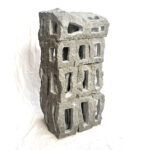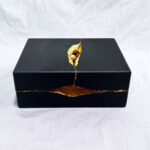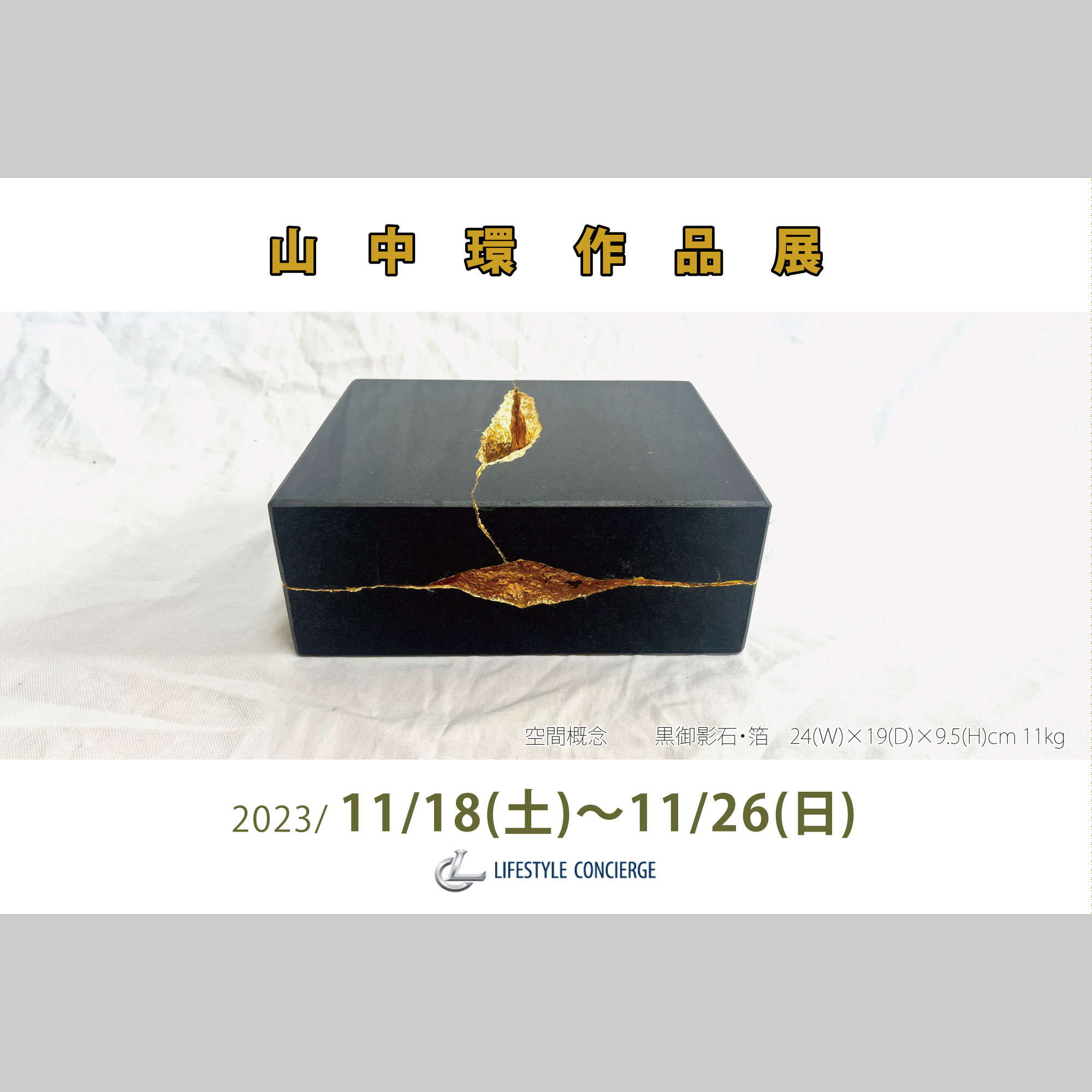「1997国際彫刻シンポジウム in 仙台」に制作助手として参加させていただいた事がきっかけで、ロシアの国際彫刻シンポジウムに参加しました。「1997国際彫刻シンポジウム in 仙台」の報告集の巻末にその時の事を書いた一文を掲載していただきました。
ロシア/カルムイク自治共和国
第2回・第3回国際彫刻シンポジウム
参加報告
「国際彫刻シンポジウムin仙台」にアシスタントとして加えていただいた折りグルジアから参加したジュンベル・ジキアさんにロシアのシンポジウムの情報を教えてもらい、海外の石彫シンポジウムに参加したいという念願のひとつをかなえることができた。
東京から約10時間30分のモスクワから東南の方向に、小さな小さなバスのような飛行機に揺られること2時間30分、ロシアに21ある自治共和国のうちのひとつ、カルムイク自治共和国の首都エリスタの、バス停のような素っ気ない飛行場に到着する。カスピ海まで続く国土は76100平方km、人口は330600人、都市部に入口の約40%が住んでいる。主な産業はカスピ海沿岸で取れる油、ガソリン(日本の約1/10の値段)、農業などである。
飛行場から車で20〜30分、町の中心街につく。大きな広場には大きなレーニンの像が立っていて、その広場に面してホワイトハウスが建っている。レーニンの像がまだ立っているだけでも驚いたけれど、この広場は週末、屋外ディスコとなり多くの若い男女でいっぱいになる。それを大音量の音楽の喧騒の中、レーニンが見ているのだ!
モンゴルから長い長い遊牧の果て、現在の地に落ち着いたカルムイク人(仏教徒)は45%ロシア人が38%。カルムイク人はモンゴルから来た民族なので顔も日本人とそっくり。町の中に仏様や寺院が建っている。
1998年の9月からここエリスタでチェス・オリンピックが開かれることになっている。それに向けて広いオリンピック村を建設中。さらに町を沢山の彫刻で飾り世界中からのシヤフマトリスト(プロのチェス指し)、その関係者、ジャーナリスト、お客さんらを迎えようと石彫シンポジウムを立て続けに開催しているということだ。第2回が1997年の10月からカフカスの砂岩を使い、第3回が1998年の5月からウラルの大理石を使ってそれぞれ45日間催された。どちらのシンポジウムも参加の条件はだいたい以下のとおりだった。
1)制作のためのスペース、石は提供される。
2)宿泊は大学の学生寮2〜3人の相部屋、食事が提供される。
3)片道運賃。(航空運賃のみ、ヘビーチャージは自前〉
4)制作のための道具はすべて持参すること。
(ヘビーチャージはかなり高額になる)
5)彫刻に支払われる謝礼は日本円で約20万円。
参加作家はロシア、ロシア連邦の自治共和国(カブレムイク共和国バシコルトスタン共和国、トゥィバ共和国、ブリヤート共和国)、カザフスタン、グルジア、ブルガリアなどからで僕以外はロシア語圏からの参加だった。どちらも10数人の作家が共に制作した。
粗取りは削岩機のような形だが打撃のみで回転しない大型のエアーツールで制作していた。スイッチはなく石に強く押し当てることで作動するようになっている。コンプレッサーはガソリン、電気の両方あったが、共通しているのは図体はでかいが力が弱い
ということだ。電気は時々停電するので、1日フルに仕事することは無理だと最初から思っていないと、精神衛生上非常に悪い。断水も珍しくないので1日の仕事が終わって汚れ切った体を洗うことができないこともしばしば。そんなときは普段からチョロチョロとしかお湯のでないシャワーでさえ恋しくなる。
カルムイクには、カッターを回す電動工具が日本円で約1万円で売っいるくらいでノミその他、石彫の道具は入手することが非常に困難。今でこそ食料には困らないけれど物が豊富にあるわけではないのだ。市場(バザール)でみんなカッターの刃を買っていたが、ダイヤモンドではなくメタルのようで御影石を彫るのはきっと不可能だろう。それすら買えないことも多く、また中心がずれていて非常に使いずらいものが少なくないようだった。彼らに言わせるとトルコ製のは粗悪品が多いそうだ。でも、朝までウォッカを飲んでも次の日一日朝からガンガン仕事ずる彼らのことノミや手ビシヤンなどを使い、体力にものをいわせて制作していた。
コンクリート基礎は空気が乾燥しているからか、コンクリートを流し込んだ2日後には作品を設置してまう、地震が無いのでステンレス棒などを入れることも無く、ただ置いて、すき間に練ったセメントを少し塗り込んで完了。
基本的にリアリスティックな彫刻を制作する作家が多く抽象彫刻は理解できないといった作家も少なからずいた。例えば、僕の作品がカルムイタ共和国に設置された初の抽象彫刻だった。基本的に肖像彫刻の伝統の流れが続いているようだ。
磨きをかけた作品ですらワイヤーで移動しなければならなかったり、制作の環境や道具について、いかに日本が進んでいるかを実感した。しかし技術や道具が進んでいることと、よい彫刻が作れることはイコールではない。ものが無くて工夫するところから手技をうながす道具が生まれたのも事実だろう。そんなことより、世界のどんなところにも彫刻家がいるということ、きっと今も彼らは良いものを創ろうとしていること、その事実が僕を怖じけさせもするが同時に勇気も与えてくれる。そしてシンポジウでは、そんな彼らと出会い実際にコミュニケーションずることができる。僕にとってそのこと自体が最も大きな喜びを感じる出来事だった。
REPORT ON THE 2ND AND 3RD INTERNATIONAL SCULPTURE SYMPOSIUMS IN THE KALMYKIAN REPUBUC, RUSSIA
At the International Sculpture Symposium in Sendai, I served as assistant to Jymber Jikia and received information from him about symposiums in Russia. I had long had a desire to participate in a stone sculpture symposium abroad and this dream had come true. After a 10 and a half hour flight from Tokyo to Moscow, I transferred to a very tiny bus-like plane and rode for another 2 and a half hours to Elista, capital of Kalmykia Republic, one of the 21 republics in Russia. The airport we landed at seemed more like a bus stop than an airport. The total land area of Kalmykia, which extends to the Caspian Sea, is 76,100 square kilometers, and of the
population of 330,600, about 40% live in urban areas. The major industries are the off-shore petroleum drilled from the Caspian Sea, gasoline (about 1/10 the price in Japan) and agriculture.
After a 20 to 30 minute ride, we entered the center of town. A large statue of Lenin stood in the large town square and the “White House” was positioned across this area. I was surprised to see the statue of Lenin but even more amazed to hear that the square becomes an outdoor disco on weekends and is crowded with young men and women. In the midst of all this raucous music and noise, Lenin gazes quietly upon the crowds. The original Kalmykian people (Buddhist believers) were nomads and traveled long distances from Mongolia to arrive at their present homeland. They make up 45% of population, and 38% are Russians. Since the Kalmykian people are natives of Mongolia, they look very similar to the Japanese. There are Buddhist statues and temples hroughout the town. In September, 1998, the “Chess Olympics” will be held in the city of Elista. A large Olympic village is under construction for this event. To welcome the professional chess players, journalists and other visitors, the town has been holding consecutive stone sculpture symposiums to create enough pieces to adorn the town and greet the guests. The Second Symposium was held in October, 1997 using sandstone from Kafkas and at the Third Symposium in May, 1998, granite from Urals was used, and each event lasted for 45 days. Terms for participation in both events were as follows:
1) Workspace and stone was provided for participants.
2) Lodging was at the university student dormitory with 2 or 3 people per room; meals were provided.
3) One-way ticket (only air fare and did not include excess baggage charge) was provided.
4) Each participant had to bring his own sculpting tools
(excess baggage charge was very expensive for this reason)
5) Honorarium of approximately 200,000 yen was paid to each sculptor.
Except for myself, all the other participants were from Russia or other republics in the Russian Federation (Republics of Kalmykia, Bashkortstan (Bashkir), Tuva, Buryat, Kazakhstan, Georgia and Bulgaria). About 10 sculptors worked on same time.
Rough hewing was carried out with an air tool resembling a drill but it did not rotate but merely struck the stone. It had no switch but operated when it was firmly pressed against the stone. Compressors ran by gasoline or electricity but the common feature for both types was that, in spite of their large size, they had little force. Power failures frequently occurred so it was difficult to work for the whole day. lt woad have been very stressful if I had not resigned myself to this situation at the very beginning. Water supply was repeatedly cut off so I often had the experience of not being able to wash the dirt and grime off after a hard day’s work. At these times, I felt nostalgic for the dribble of warm water from the so-called shower.
ln Kamykia, an electric tool that rotates the cutter cost about 10,000 yen and was just about the only tool available. Other tools like chisels and instruments for stone sculpting were very difficult to find. Although a suffcient food supply was no longer a problem, material goods were still not abundant. Everyone was buying cutter blades at the bazaar, and since they were metal, not diamond, carving granite with them was difficult. Even these were sometimes difficult to obtain and occasionally the center of the blades was uneven so were very difficult to use. The other sculptors told me that Turkish products were of very poor quality. However, even after
drinking vodka into the early hours of the morning, they would get up the next morning eager to work. Using only chisels, they depended on their stamina to produce their best work.
Possibly because of the dry air, the concrete foundation was poured only two days after the sculpture was completed. Because there are no earthquakes, it was not necessary to insert stainless steel bars. The work was installed and the cracks filled with cement, and the setting was completed. The majority of the sculptors produced realistic pieces and some could not understand abstract sculpture. For example, my piece was the first abstract work to be installed in the Kalmykian Republic. There is a long tradition of sculpture of
effigies and this trend continues to this day.
Even polished works sometimes had to be moved by wire, and I realized how advanced Japan was in terms of working environment and tools. However, this does not mean that a high quality of technique and tools necessarily results in great work. In fact, in other parts of the world, sculptors are constantly creating great pieces; this fact has humbled me as well as given me courage. At the symposiums, I was able to meet and communicate with these courageous sculptors. For me, this was the greatest joy.
英訳は「1997国際彫刻シンポジウム in 仙台」報告集より転載。


